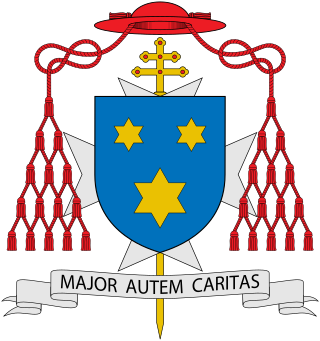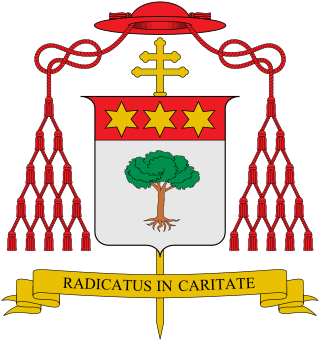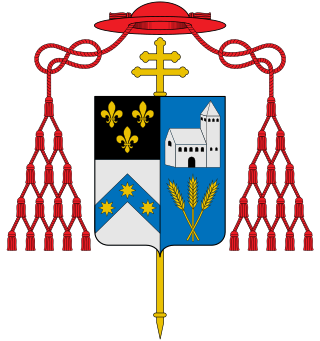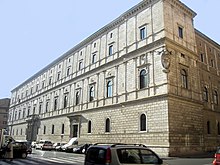The Roman Curia comprises the administrative institutions of the Holy See and the central body through which the affairs of the Roman Catholic Church are conducted. The Roman Curia is the institution which the Roman Pontiff ordinarily makes use of in the exercise of his supreme pastoral office and universal mission in the world. It is at the service of the Pope, successor of Peter, and of the Bishops, successors of the Apostles, according to the modalities that are proper to the nature of each one, fulfilling their function with an evangelical spirit, working for the good and at the service of communion, unity and edification of the Universal Church and attending to the demands of the world in which the Church is called to fulfill its mission.
The politics of Vatican City take place in a framework of a theocratic absolute elective monarchy, in which the Pope, religiously speaking, the leader of the Catholic Church and Bishop of Rome, exercises ex officio supreme legislative, executive, and judicial power over the Vatican City as it is being governed by the Holy See, a rare case of non-hereditary monarchy.

Carlo Mario Francesco Pompedda was an Italian cardinal of the Roman Catholic Church and the Prefect of the Apostolic Signatura for the Roman Curia. He spent nearly fifty years in a variety of posts within the Catholic Church's ecclesiastical court system, from 1955 to 2004.

The Dicastery for the Eastern Churches, previously named Congregation for the Oriental Churches or Congregation for the Eastern Churches, is a dicastery of the Roman Curia responsible for contact with the Eastern Catholic churches for the sake of assisting their development and protecting their rights. It also maintains whole and entire in the one Catholic Church the heritage and canon law of the various Eastern Catholic traditions. It has exclusive authority over the following regions: Egypt and the Sinai Peninsula, Eritrea and northern Ethiopia, southern Albania and Bulgaria, Cyprus, Greece, Iran, Iraq, Lebanon, Israel, Syria, Jordan and Turkey, and also oversees jurisdictions based in Romania, Southern Italy, Hungary, India and Ukraine.
The Roman Rota, formally the Apostolic Tribunal of the Roman Rota, and anciently the Apostolic Court of Audience, is the highest appellate tribunal of the Catholic Church, with respect to both Latin Church members and the Eastern Catholic members and is the highest ecclesiastical court constituted by the Holy See related to judicial trials conducted in the Catholic Church. An appeal may be had to the pope himself, who is the supreme ecclesiastical judge. The Catholic Church has a complete legal system, which is the oldest in the West still in use. The court is named Rota (wheel) because the judges, called auditors, originally met in a round room to hear cases. The Rota was established in the 13th century.
Doctor of Canon Law is the doctoral-level terminal degree in the studies of canon law of the Roman Catholic Church. It can also be an honorary degree awarded by Anglican colleges. It may also be abbreviated ICD or dr.iur.can., ICDr, DCL, DCnl, DDC, or DCanL. A doctor of both laws is a JUD or UJD.

Agostino Vallini is an Italian prelate of the Catholic Church. He has been a cardinal since 2006. From 2008 to 2017 he served as Vicar General of Rome. He is also the Archpriest emeritus of the Archbasilica of St. John Lateran.
The Dicastery for Legislative Texts, formerly named Pontifical Council for Legislative Texts, is a dicastery of the Roman Curia. It is distinct from the highest tribunal or court in the Church, which is the Supreme Tribunal of the Apostolic Signatura, and does not have law-making authority to the degree the Pope and the Holy See's tribunals do. Its charge is the interpretation of existing canon laws, and it works closely with the Signatura and the other Tribunals and the Pope. Like the Signatura and the other two final appellate Tribunals, the Roman Rota and the Apostolic Penitentiary, it is led by a prefect who is a bishop or archbishop.

Francesco Roberti was an Italian cardinal of the Roman Catholic Church. He served as prefect of the Apostolic Signatura in the Roman Curia from 1959 to 1969, and was elevated to the cardinalate in 1958. He was also known for his work in moral theology.

Francesco Morano was an Italian Cardinal of the Roman Catholic Church. He served as Secretary of the Apostolic Signatura in the Roman Curia from 1935 until 1959, and was elevated to the cardinalate in 1959.

Massimo Massimi was an Italian cardinal of the Roman Catholic Church who served as Prefect of the Apostolic Signatura in the Roman Curia from 1946 until his death, and was elevated to the cardinalate in 1935.

Dino Staffa was an Italian cardinal of the Roman Catholic Church. He served as prefect of the Apostolic Signatura from 1967 until his death, and was elevated to the cardinalate in 1967.

Aurelio Sabattani JUD was an Italian cardinal of the Roman Catholic Church. He served as Prefect of the Apostolic Signatura from 1967 until his death and was elevated to the rank of cardinal in 1983.

Giuseppe Casoria was an Italian Cardinal of the Roman Catholic Church who served as Prefect of the Congregation for Sacraments and Divine Worship from 1981 to 1984, and elevated to the cardinalate in 1983.

Giuseppe Versaldi is an Italian prelate of the Catholic Church who was the prefect of the Congregation for Catholic Education from 2015 until that body was merged into the new Dicastery for Culture and Education in 2022. He served as president of the Prefecture for the Economic Affairs of the Holy See from 2011 to 2015. Before that he was Bishop of Alessandria. Pope Benedict XVI elevated him to the rank of cardinal on 18 February 2012.
The law of Vatican City State consists of many forms, the most important of which is the canon law of the Catholic Church. The organs of state are governed by the Fundamental Law of Vatican City State. The Code of Penal Procedure governs tribunals and the Lateran Treaty governs relations with the Italian Republic.

Pontificalis Domus was a motu proprio document issued by Pope Paul VI on 28 March 1968, in the fifth year of his pontificate. It reorganized the Papal Household, which had been known until then as the Papal Court.

Pietro Marini was a Catholic cardinal.
Edward Neal Peters is an American Roman Catholic canonist and serves as a referendary of the Apostolic Signatura. In 2023, he is professor of canon law at the Sacred Heart Major Seminary of the Archdiocese of Detroit.
Dignitas connubii is an instruction issued by the Pontifical Council for Legislative Texts on 25 January 2005 on the discipline to be observed in diocesan and interdiocesan tribunals regarding causes of the nullity of marriage. It was compiled in close concert with dicasteries that have a related competence, namely, the Congregation for the Doctrine of the Faith, the Congregation for Divine Worship and the Discipline of the Sacraments, the Supreme Tribunal of the Apostolic Signatura, and the Tribunal of the Roman Rota. It was partially obrogated by the matrimonial nullity trial reforms of Pope Francis in 2015, but remains in effect.














